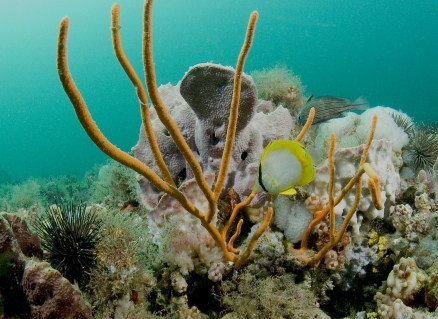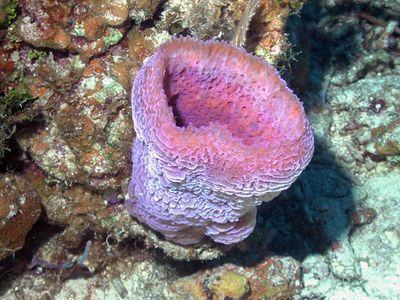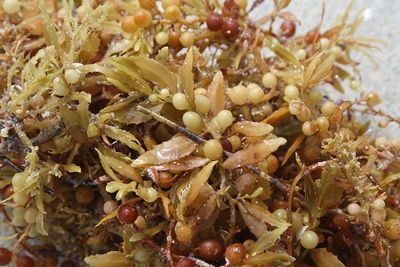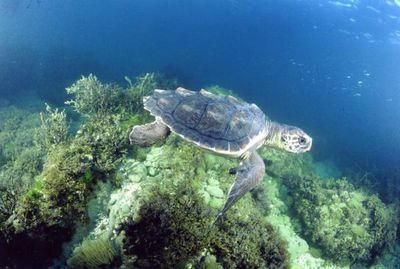Gray’s Reef National Marine Sanctuary
Contents
Introduction
Within the 17-square-nautical-mile sanctuary, there are both rocky ledges and sandy flat places. The reefs' rock ledges, submerged beneath 60 to 70 feet of water, can be as tall as 6-8 feet and are highly complex, with nooks and crannies that provide habitat for invertebrates and fishes to hide. The attached invertebrates form a dense carpet of living creatures that in places completely hides the rock. This feature gives the habitat of Gray's Reef its common name -- a "live bottom."Gray's Reef National Marine Sanctuary, designated in January 1981, is one of the largest near-shore live-bottom reefs in the southeastern United States. The sanctuary is located 32 kilometers (17.5 nautical miles) off Sapelo Island, Georgia and encompasses 58 square kilometers (17 sq. nautical miles) of live-bottom habitat. It is one of 13 marine sanctuaries that make up the National Marine Sanctuary System.
Gray's Reef Name
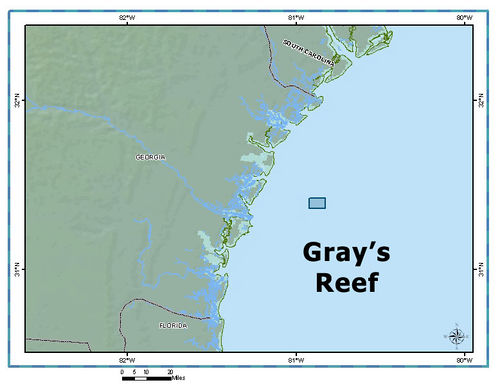 (http://sanctuaries.noaa.gov/library/imast_gis.html) Gray's Reef was made an Active Candidate for listing as a National Marine Sanctuary in 1979. Final designation as a National Marine Sanctuary came in January 1981. Gray's Reef National Marine Sanctuary was named in recognition of Milton "Sam" Gray, who studied the area in the 1960's as a biological collector and curator at the University of Georgia Marine Institute on Sapelo Island, Georgia. The near-shore hard-bottom reef off the coast of Sapelo Island was recognized by Sam Gray in 1961 in connection with his extensive biological surveys of the ocean floor off the Georgia coast. Collections made during the surveys are under the protective supervision of the University of Georgia Natural History Museum and maintained as the “Gray’s Reef Collection.” In 1974, Jesse Hunt, a graduate student working under Jim Henry was the first scientist to study the reef. He proposed the name “Gray’s Reef” for this live-bottom habitat to commemorate Sam’s valuable contribution to the understanding of offshore habitats and marine organisms, especially those of the near-shore continental shelf of Georgia. The Georgia Department of Natural Resources submitted a nomination to the Secretary of Commerce in June 1978 recommending the designation of Gray’s Reef as a marine sanctuary.
(http://sanctuaries.noaa.gov/library/imast_gis.html) Gray's Reef was made an Active Candidate for listing as a National Marine Sanctuary in 1979. Final designation as a National Marine Sanctuary came in January 1981. Gray's Reef National Marine Sanctuary was named in recognition of Milton "Sam" Gray, who studied the area in the 1960's as a biological collector and curator at the University of Georgia Marine Institute on Sapelo Island, Georgia. The near-shore hard-bottom reef off the coast of Sapelo Island was recognized by Sam Gray in 1961 in connection with his extensive biological surveys of the ocean floor off the Georgia coast. Collections made during the surveys are under the protective supervision of the University of Georgia Natural History Museum and maintained as the “Gray’s Reef Collection.” In 1974, Jesse Hunt, a graduate student working under Jim Henry was the first scientist to study the reef. He proposed the name “Gray’s Reef” for this live-bottom habitat to commemorate Sam’s valuable contribution to the understanding of offshore habitats and marine organisms, especially those of the near-shore continental shelf of Georgia. The Georgia Department of Natural Resources submitted a nomination to the Secretary of Commerce in June 1978 recommending the designation of Gray’s Reef as a marine sanctuary.
Origin Of Gray's Reef
Gray's Reef is a consolidation of marine and terrestrial sediments (sand, shell, and mud) which was laid down as loose aggregate between 6 and 2 million years ago. Some of these sediments were probably brought down by coastal rivers draining into the Atlantic and others were brought in by currents from other areas. More of these sediments accumulated until a dramatic change began to take place as a result of global cooling during the Pleistocene Epoch, between 2 million and 8,000 years ago. It was during this time that the area which is now Gray's Reef was exposed as dry land and the shoreline was as much as 80 miles seawrad of its present location. As a result of this exposure, the sediments became solidified into porous limestone sandstone rock. As the glacial ice melted, the water flowed back towards the sea, refilling the basins.
Profile of Gray's Reef Habitats
Flat Top Ridge: Horizontal reef tops provide habitat for sessile (attached) benthic (bottom:dwelling) invertebrates that rely on ocean currents for suspended food, gas exchange, waste removal, and dispersal of propagules (eggs, larvae, or spores). Major sessile invertebrates include hard corals, soft corals, sponges, and hydroids.Waters above the Reef: Planktonic (drifting) and nektonic (swimming) invertebrates and fishes are found in the waters above the reef. Planktonic species include microscopic algal and zooplankton as well as large medusae such as the sea nettle and the cannonball jelly. Squid exemplify a nektonic species that actively pursue prey in these waters.
Scarps: Little sediment accumulates on the vertical reef surfaces known as scarps. As a result, the bare substrate supports colonies of encrusting sponges and bryozoans (mossy animals). Barnacles, tunicates, and sea anemones are also found on these exposed surfaces.
Ledges and Crevices: Both predators and prey seek out hiding places within the reef. Diurnal (active during day) species find refuge within the reef during the night. Nocturnal (active at night) species conceal themselves within the reef during daylight. Lobsters, crabs, sea urchins, and octopods prefer this type of habitat.
Slopes and Sandy Areas: Shifting sands and a lack of firm substrate preclude most sessile forms from settling along slopes and in sandy areas of the reef. Burrowing clams, mobile snails, sea stars, and burrowing polychaete worms are better adapted to life in these loose sediments.
Flat Bottom Troughs: Among the rock rubble, coarse sands, and shell fragments of the flat bottom troughs are found brittle stars, fan and tube worms, burrowing crustaceans, small crabs, and snails. This habitat is also preferred by certain burrowing echinoderms such as the sea cucumber.
Invertebrates of the reef have adapted to the specific resource characteristics of habitats described above. This ability to adapt to different, specific resources helps to decrease competition for food and space among the residents of the reef, thus allowing for a greater diversity of species within the community.
Flora and Fauna
Marine Mammals
Marine mammals in Gray’s Reef National Marine Sanctuary include cetaceans (dolphins and whales) and sirenians (manatees). These marine mammals spend their entire lives in the water. Many species are social and can be found living alone or in large aggregations. Cetaceans can dive for extended periods of time to great depths. Manatees are vegetarians and have large, mobile lips with stiff bristles which help them feed. Most marine mammals in Gray’s Reef are not permanent residents and either use the sanctuary during their migration or as part of their larger home range.
Fishes
This group includes bony fishes as well as cartilaginous fishes such as sharks, rays and skates living on or near the reef. There is a tremendous diversity of fish in the Gray’s Reef National Marine Sanctuary, with up to 150 species recorded. The fishes found in Gray’s Reef National Marine Sanctuary have diverse lifestyles and ecological roles: some live on the reef, some visit the reef occasionally for feeding, and some live in or on the sand surrounding the reef. Also, some of these fish only live in Gray’s Reef for part of the year, depending on the temperature of the water. Five species of sharks live in the sanctuary: nurse shark, spiny dogfish, lemon shark, tiger shark and the great hammerhead.
Marine Birds
Seabirds do not comprise a taxonomic or evolutionary group of birds; they are simply defined as birds that spend most of their life feeding and living on the open ocean, coming only to land to breed. Due to the offshore location of Gray’s Reef, the seabirds represented here primarily use the sanctuary as offshore habitat.
Invertebrates
Invertebrates in Gray’s Reef include mollusks (snails, clams), echinoderms (sea stars, urchins, sea cucumbers), tectibranchs (sea hares), arthropods (lobster, crabs, shrimp), annelids (worms), porifera (sponges), cnidarians (jellies, anemones, corals), and many others. This great diversity of animals can be found in all habitats of the marine sanctuary including coral and rocky reefs, sandy bottoms, and the open ocean.
Plants and Algae
Both vascular plants and algae (seaweeds) are primary producers, forming the base of the food web in the ocean. The most common alga found in Gray’s Reef National Marine Sanctuary is the Sargassum weed, which is a common species of the warm-temperate region along the southeast coast of the United States. There are at least 68 species of plants and algae in the sanctuary, some of which are endemic (found only in this location in the world). The presence of algae and plants in this region is highly seasonal – there are few species present in the winter but many settle and grow in the spring and summer, providing food and habitat for a variety of marine organisms.
Marine Reptiles
Reptiles are relatively uncommon residents of the marine environment. Of the small group or reptiles that inhabit the sea, the most common and easily recognized are the sea turtles. There are only seven species of sea turtles throughout the world, and all but one species are endangered. Gray’s Reef is important habitat for the threatened loggerhead sea turtle.
Further Reading
| Disclaimer: This article is taken wholly from, or contains information that was originally published by, the National Marine Sanctuary. Topic editors and authors for the Encyclopedia of Earth may have edited its content or added new information. The use of information from the National Marine Sanctuary should not be construed as support for or endorsement by that organization for any new information added by EoE personnel, or for any editing of the original content. |
